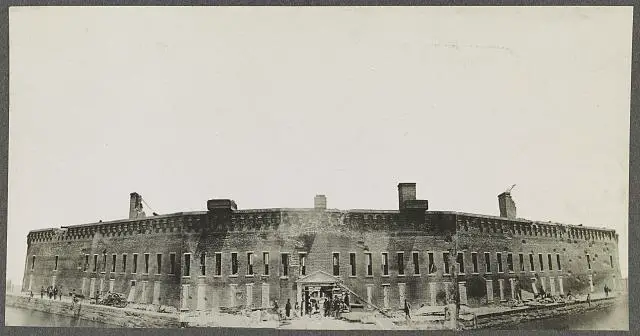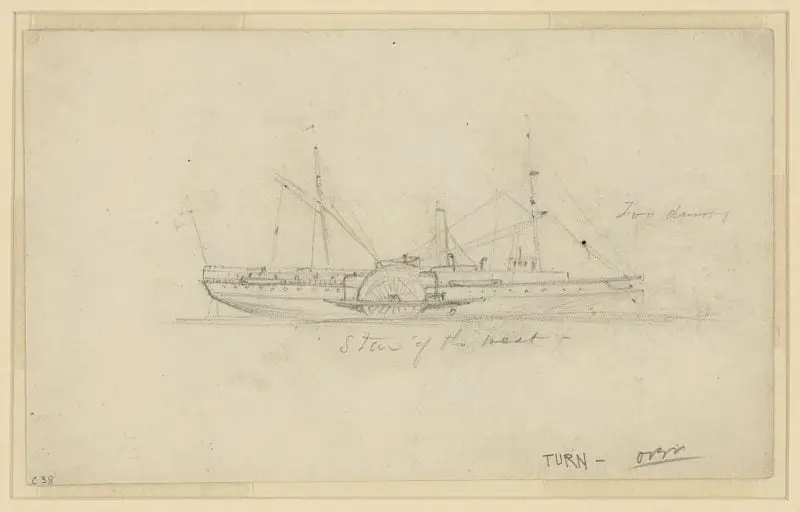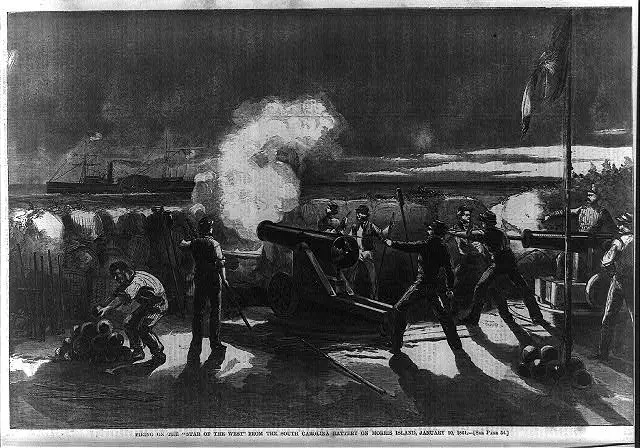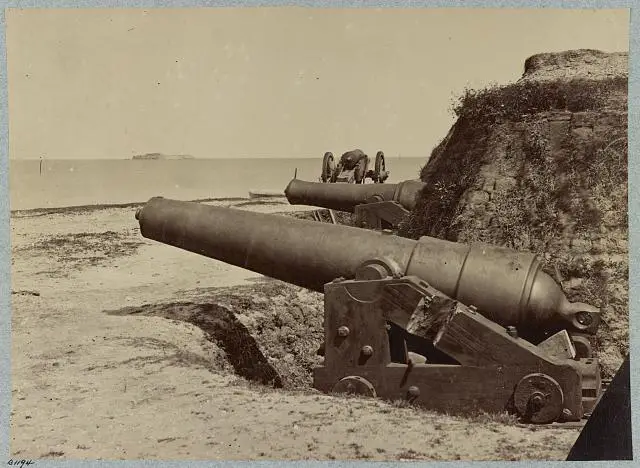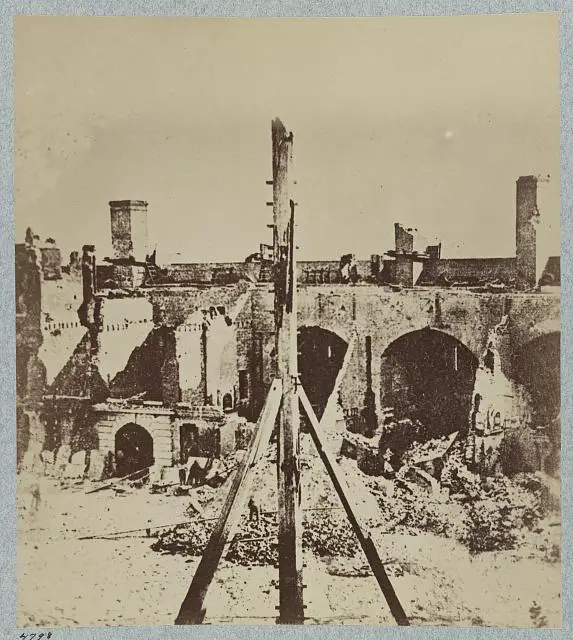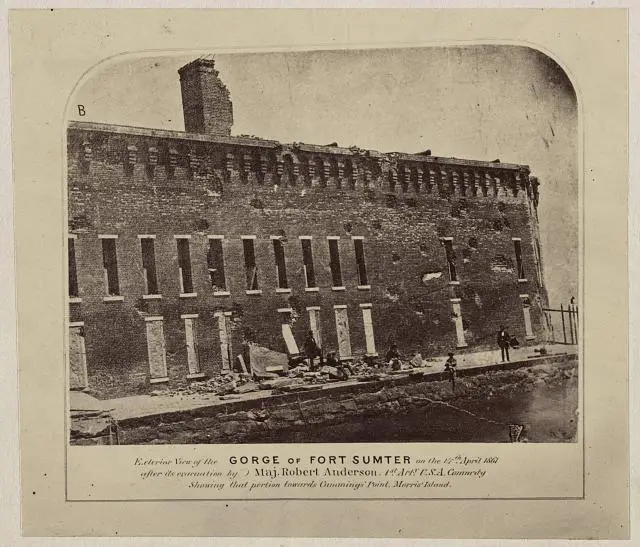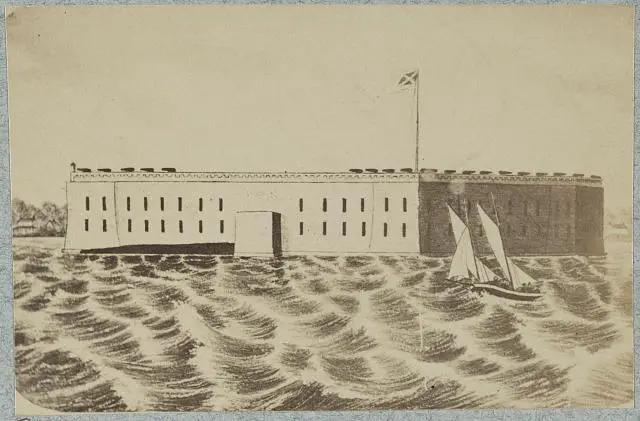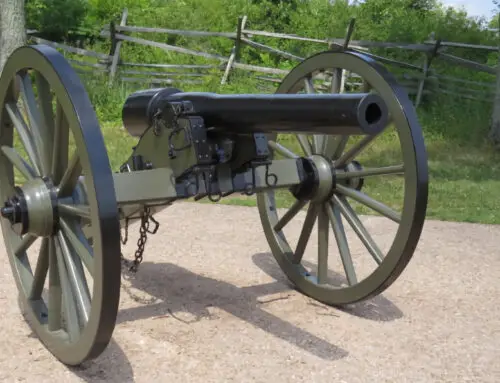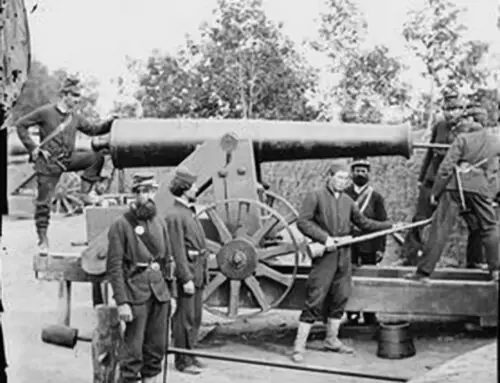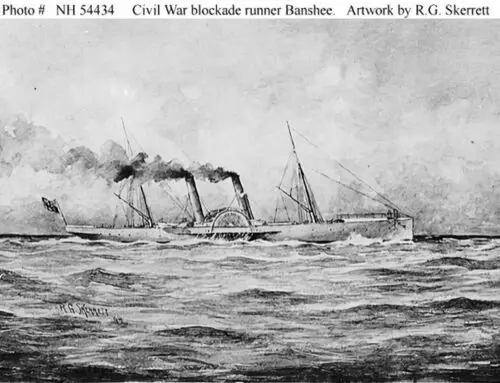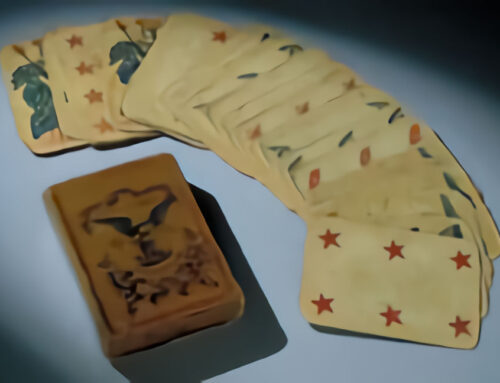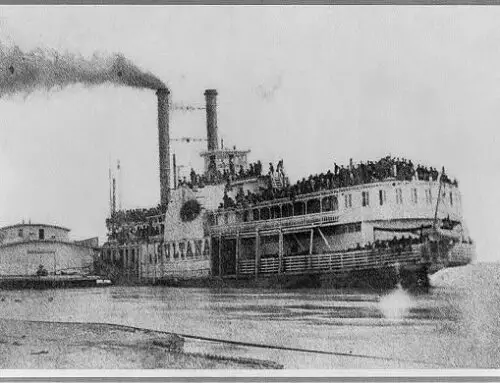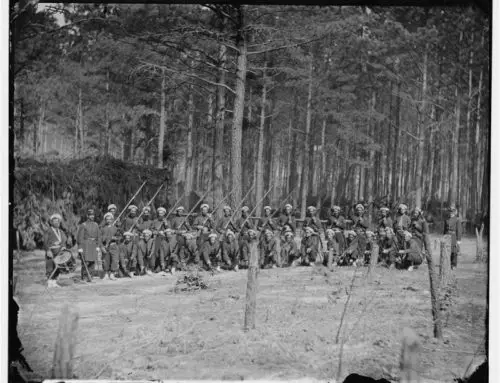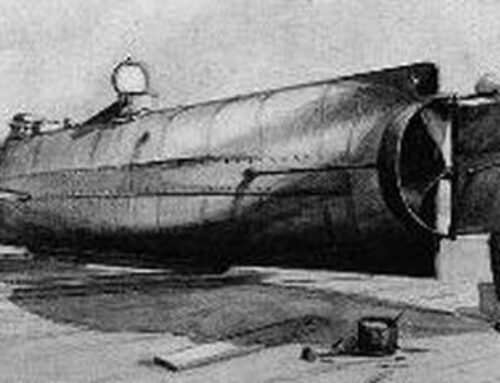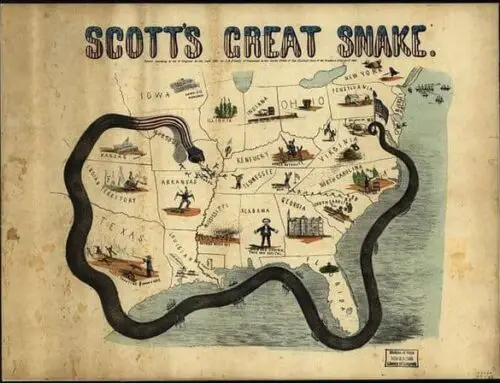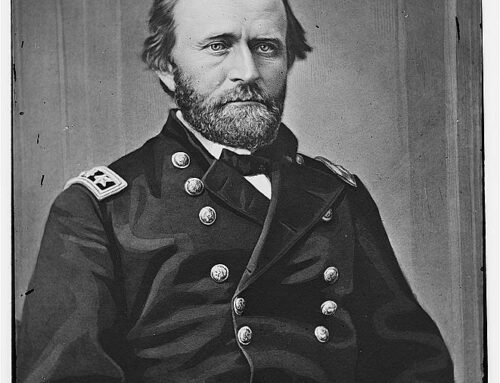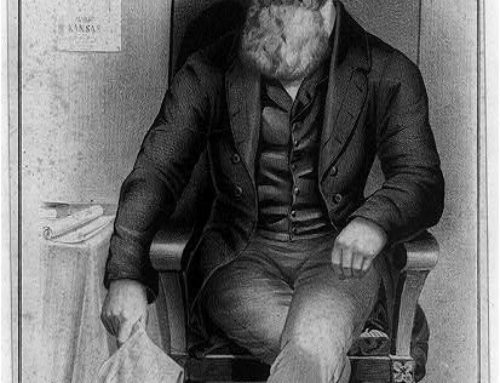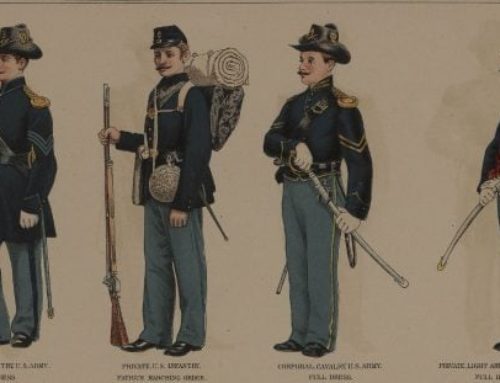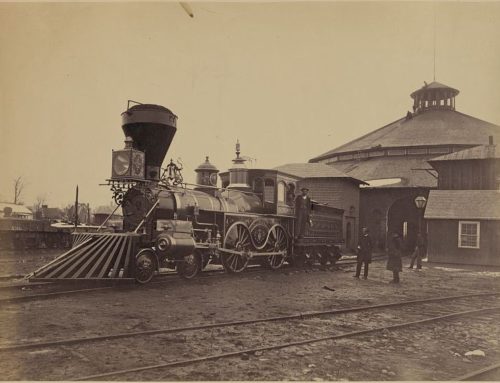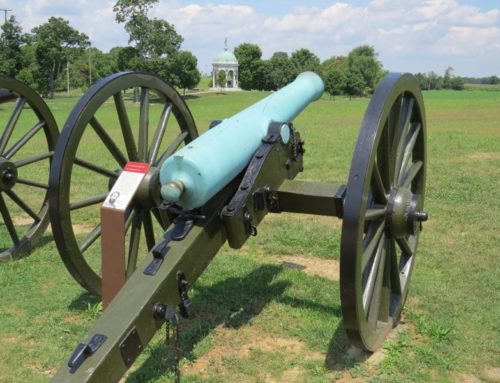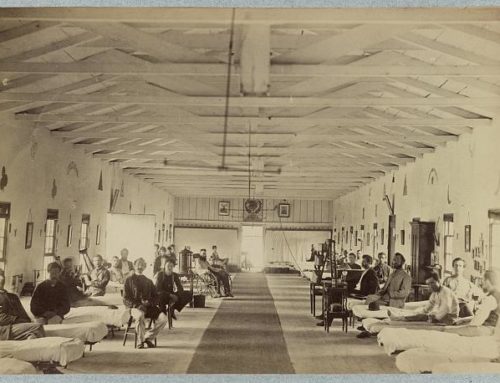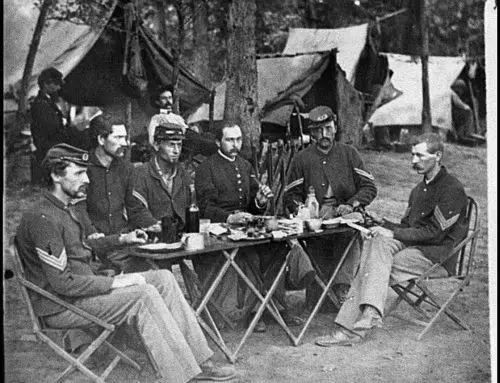The American Civil War officially started with the battle of Fort Sumter in South Carolina on April 12th 1861.
Fort Sumter Facts
- Location: Charleston County
- Campaign: Operations in Charleston Harbor (April 1861)
- Date(s): April 12-14, 1861
- Principal Commanders: Maj. Robert Anderson [US]; Brig. Gen. P.G.T. Beauregard [CS]
- Forces Engaged: Regiments: 580 total (US 80; CS est. 500)
- Estimated Casualties: None
- Result(s): Confederate Victory
The garrison of Fort Sumter was originally stationed in nearby Fort Moultrie under the command of Union Major Robert Anderson.
Fort Moultrie, was a poor fort for defense, and he predicted that his men would only be able to resist a Confederate attack for no more than a couple of days.
Fort Sumter was one of several forts that guarded Charleston Harbor South Carolina.
The other forts were Fort Moultrie, Castle Pinckney, and Fort Johnson. The strongest of these forts was by far Fort Sumter which was located on an island at the entrance to the harbor.
Meanwhile in the state of Florida a very similar situation was developing in Pensacola Harbor at Fort Pickens.
The two almost identical events had opposite results. South Carolina seceded from the United States on December 20th 1860. This made South Carolina the first state to secede from the Union.
Major Anderson therefore decided to move his garrison from Fort Moultrie over to Fort Sumter on December 26th 1860. He made this move without orders. He deemed the transfer necessary since Fort Sumter was a much stronger fort that could withstand a siege by Confederate troops.
The garrison of Fort Sumter was very small. As of March 24th 1861 it consisted of only 10 officers, 75 enlisted men and 55 laborers who were used to construct and improve the defenses of the fort.
Originally there were 205 laborers, however 150 of them were discharged on December 28th 1860.
Confederate South Carolina troops immediately seized Fort Moultrie and Castle Pinckney on December 27th after the Union troops had abandoned them.
The Charleston Arsenal was also taken by state troops on December 30th
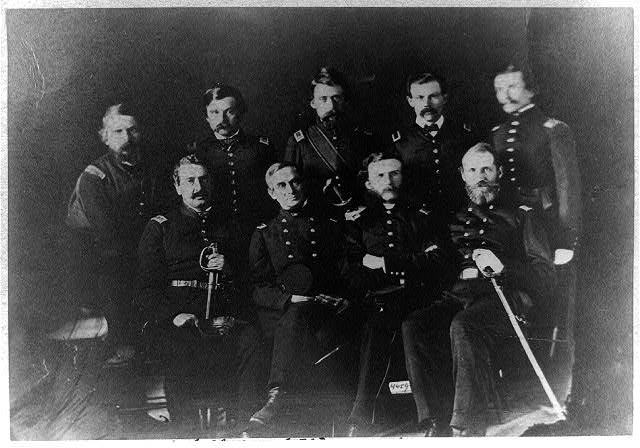
Union Officers at Fort Sumter. In front row: Capt. A. Doubleday, Major R. Anderson, Asst. Secry. S. W. Crawford, Capt. J. S. Foster. From left in back row: Capt. T. Seymour, Lt. G. W. Snyder, Lt. J. C. Davis, Lt. R. K. Meade, Capt. T. Talbot.
Fort Johnson was taken by the rebels on January 2nd 1861. The Union garrison did not resist the Confederate seizure of these forts or the arsenal.
After Major Anderson transferred his men to Fort Sumter they quickly went to work improving it’s defenses.
In December 1860 the garrison at Fort Sumter only had four months supply of provisions.
They would need to be resupplied if they were going to hold out for any length of time in the event of an attack by Confederate forces.
Resupply of Fort Sumter
On December 31st 1860 General Winfield Scott issued an order to Colonel Dimick the commanding officer of Fort Monroe in New York to prepare the sloop of war Brooklyn.
He was ordered to put on board two hundred men with three months worth of supplies. They were to sail to South Carolina and reenforce Fort Sumter as soon as possible.
In order to keep this mission a secret it was decided to use a private passenger ship instead of the Brooklyn or any Union navy ship. The ship to be used was called the Star of the West.
It’s owner agreed to charter his ship to the US government for $1,250 per day. This ship routinely went to New Orleans on it’s regular route so it would not arouse suspicion when it sailed south.
On January 5th 1861 First Lieutenant Charles Woods left Governor’s Island New York on the steamer Star of the West with 200 men and supplies for Fort Sumter. Three days later at midnight on January 8th they arrived off of Charleston Harbor.
In the darkness they proceeded to head in the direction of Fort Sumter. Near daybreak they were only three quarters of a mile away from the fort.
As they approached Lt. Woods noticed a red Palmetto flag flying near the areas the Confederate troops were known to be occupying. The steamer immediately came under attack by batteries stationed on the north end of Morris Island.
They could see the American flag flying above Fort Sumter, however they were under a constant attack from the Confederate artillery. Fortunately all of the shells missed the Star of the West except for one shot that ricocheted into the ship but causing no damage.
Under this heavy bombardment by rebel forces Lt. Woods decided he could not safely reach Fort Sumter. He ordered the ship to turn around and leave Charleston Harbor.
The rebel battery continued to fire on the ship until they were out of the harbor. The Star of the West failing to resupply the fort, set sail back to New York arriving there on January 12th.
A Second Attempt to Resupply the Fort
A second expedition was sent to resupply the fort. Leaving New York on April 10th and arriving on April 12th this force was led by Captain Fox on the steamer The Baltic.
The force was originally suppose to consist of the steam tugs Uncle Ben, The Yankee, and the Freeborn, which were to meet up at Charleston Harbor with the steamer Harriet Lane, Pawnee, Powhatan and the Pocahontas.
The Uncle Ben, The Yankee, the Freeborn, Powhatan, and the Pocahontas never arrived at Charleston Harbor. This meant that only the Baltic, the Harriet Lane and the Powhatan were available for the resupply effort for Fort Sumter. The weather was bad with gale force winds and rain. Captain Fox on the Baltic decided to attempt to reach the fort despite the bad weather.
On approaching the fort the Baltic struck and became stuck on Rattlesnake Shoal, however they were quickly able to free the ship. The Baltic withdrew without reaching the fort.
Captain Fox made another relief attempt on the night of April 13th. It failed to reach the fort. The high seas and terrible weather coupled with the failure of the other ships to arrive doomed the expedition from the beginning.
Confederates Offer Terms of Surrender
At 3:45 pm on April 11th the commander of the Confederate forces in Charleston, South Carolina General P.G.T. Beauregard sent an envoy consisting of Colonel Chesnut, Colonel Chisolm and Captain Lee with a letter asking Major Anderson to evacuate the fort.
Major Anderson refused this demand stating that his obligations to his honor and his government prevented him from evacuating the fort.
At 4:40 pm as the envoy left the fort, Major Anderson said “Gentlemen, if you do not batter the fort to pieces about us, we shall be starved out in a few days”.
General Beauregard intrigued by this remark sent another envoy to the fort at 12:45 am on April 12th asking for clarification of the comment made by Major Anderson and again asking him to evacuate the fort and wanting to know when would be a good time for the evacuation?
General Beauregard also assured Major Anderson that the Confederates would not open fire on the fort unless they were fired upon first.
At 3:15 am Major Anderson gave his reply. He agreed to evacuate the fort, and that he would leave by noon on April 15th if transportation could be provided.
However he would stay and fight if he received further instructions from the US government, was resupplied, or if he thought that the Confederates were taking any hostile action against his fort or his government.
These terms did not satisfy the Confederates since Major Anderson was so willing to break the agreement if anything were to change. Therefore the envoy informed Major Anderson that the fort would be fired upon within the hour. They left Fort Sumter at 3:30 am.
The Civil War Begins with the Confederate Attack on Fort Sumter
At 4:30 am a signal shell was fired from the mortar battery on James island. Captain George S. James the commander at Fort Johnson was given the honor of firing the first shot starting the battle of Fort Sumter.
At about 4:45 am the other batteries surrounding Fort Sumter began to open fire as well. In total thirty guns and seventeen mortars fired from all of the batteries surrounding the fort from the north, northeast, southeast, and southwest.
This began the bombardment of Fort Sumter.
At 7:00 am Fort Sumter began to return fire. The first shot being fired under the charge of Captain Abner Doubleday who was second in command of the garrison under Major Anderson.
The soldiers in the fort were put on three shifts of two hours each firing the guns. Even the workmen who’s only job was to build up the defenses of the fort volunteered to act as cannoneers and also help carry ammunition to the guns.
The fort had a total of 78 guns, however there were only 700 rounds of ammunition for all of the guns. Only the guns on the casement tier of the fort were used, and of these only six were used due to the shortage of ammunition.
These guns were a smaller caliber and couldn’t hit many of the targets they were shooting at. They were able to fire on Fort Moultrie inflicting minor damage.
For Sumter received heavy damage from the shelling. This damage was primarily cause by seventeen mortars the Confederates were using. These mortars could shoot vertically over the walls and into the fort.
These mortars hit the fort with great accuracy. It was for this reason that Major Anderson decided not to use the guns on the top tier of the fort, and only use the casement tier guns.
If he put his men on the top tier of the fort the mortar fire they would be exposed to would have caused high casualties among the soldiers.
The brickwork of the fort was only minimally damaged however the interior suffered severe damage.
The Confederates were firing hotshot, which is a cannon ball that is heated to a high temperature with the intention of causing fires when it strikes something.
Fires burned most of the interior which included the barracks, quarters, gun carriages, and stairs.
Negotiations Take Place at Fort Sumter
On the second day of the battle of Fort Sumter April 13th at 12:30pm the flag flying over Fort Sumter had been knocked down by the bombardment. Seeing no flag flying over the fort General Beauregard sent Colonel Chisolm to the Confederate commander on Morris island General James Simons.
Beauregard ordered Simons to offer assistance in extinguishing the fires in Fort Sumter. Colonel Chisolm and Colonel Wigfall volunteered to go to Fort Sumter and offer assistance.
As Colonel Chisolm was preparing his small boat to go to the fort, Colonel Wigfall hoped in a different boat and proceeded to the fort. In the meantime the United States flag was re-raised over the fort. Colonel’s Chisolm and Wigfall were both ordered to return, Wigfall not hearing the order continued to Fort Sumter.
He was carrying a white flag to ascertain whether Major Anderson needed assistance. With fires raging, and the men under great stress, the Confederates wanted to give the garrison an opportunity to surrender the fort.
The now unauthorized offer from Colonel Wigfall even let Major Anderson decide the terms of the evacuation.
Major Anderson agreed only if General Beauregard’s original terms of April 11th would be met.
These terms of evacuation were “to evacuate the fort with his command, taking all arms and all private and company property, saluting the United States flag as it was lowered, and being conveyed, if he desired it, to any northern port”.
Colonel Wigfall agreed to the terms and Major Anderson hoisted a white flag above the fort. Shortly after Colonel Wigfall left the fort three more of General Beauregard’s aides Captain Stephen D. Lee, William Porcher Miles, and Roger A. Pryor arrived at the fort to offer any assistance and aid that they could to Major Anderson. Major Anderson explained that he had just made a deal with Colonel Wigfall.
They were unaware of Colonel Wigfall’s offer of peace with Major Anderson. They told Major Anderson they were not authorized to offer terms of surrender, they were only there to help put out the fort’s fires.
Major Anderson realizing there was a serious miscommunication happening threatened to raise the United States flag once again and resume firing his guns.
General Beauregard also unaware that this negotiation with Colonel Wigfall had just taken place was informed that a white flag had been hoisted above the fort.
He quickly dispatched his chief of staff Major David R. Jones with some other aides to the fort to offer virtually the same terms of surrender Colonel Wigfall had offered. Despite the miscommunication Major Jones’s offer of surrender was accepted by Major Anderson.
On April 13th 1861 Fort Sumter fell to the Confederacy. The bombardment lasted for thirty-three hours. While the fort was damaged none of the soldiers in the fort were killed however some were wounded.
It was only after the battle that upon lowering and saluting the United States flag, (which involves firing cannons) a soldier was killed another was mortally wounded and four were severely wounded when a cannon prematurely fired causing an explosion of a nearby pile of cartridges.
On April 14th the Confederates put the garrison on the steamer Isabel which transferred them to the Union ship the Baltic, which was still waiting outside of Charleston Harbor after it’s failed resupply mission.
The garrison sailed for New York on April 15th.
The Confederate flag was hoisted upon the ramparts of Fort Sumter. The nearby forts cheered and fired their guns in salute of their victory.
An Ominous Moment
A curious event occurred on the evening of April 11th shortly before hostilities broke out. The Superintendent of the Citadel Academy Major P.F. Stevens who was in command of the Point and Iron batteries was observing Fort Sumter when he and several others noticed the United States flag above the fort suddenly “split in two distinct parts, dividing from the front edge to the back just along the lower extremity of the “Union”.
The flag flew like this for several minutes before it was hauled down and a new flag replaced it. Major Stevens asked “I wonder if that is emblematical?”
Several of his fellow onlookers remarked that it appeared to be an ominous sign. They could never have known how right they were.
After the Union Surrender
While the Union may have surrendered and evacuated Fort Sumter, the United States government wanted the fort back. Over the course of the war the Union proceeded to bombard the fort from land and sea.
These attacks crushed Fort Sumter’s walls, but the fort was never taken by the United States. The operations of General William T. Sherman after his march to the sea forced the Confederates to evacuate the fort in 1865.
On April 14th 1865 the same day the fort surrendered in 1861 Major Robert Anderson was given the honor to raise the same flag he was forced to lower four years earlier.

